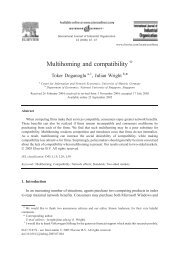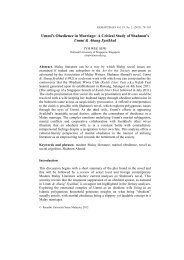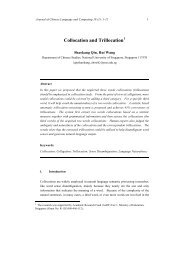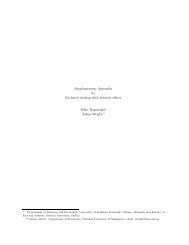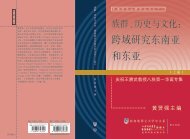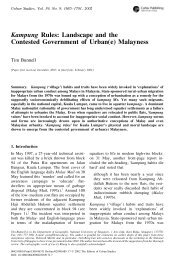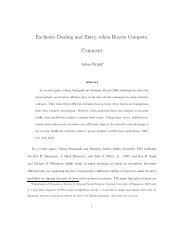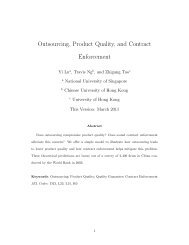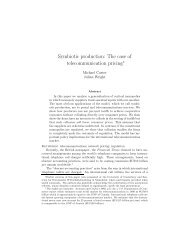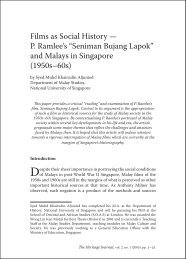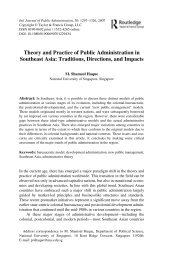Race and Multiculturalism in Malaysia and Singapore
Race and Multiculturalism in Malaysia and Singapore
Race and Multiculturalism in Malaysia and Singapore
Create successful ePaper yourself
Turn your PDF publications into a flip-book with our unique Google optimized e-Paper software.
<strong>Race</strong> <strong>and</strong> <strong>Multiculturalism</strong> <strong>in</strong><strong>Malaysia</strong> <strong>and</strong> S<strong>in</strong>gaporeEdited by Daniel P.S. Goh, MatildaGabrielpillai, Philip Holden <strong>and</strong>Gaik Cheng Khoo<strong>Race</strong>_multiculturalism_02.<strong>in</strong>dd v15/4/09 11:44:25 AM
<strong>Race</strong> <strong>and</strong> <strong>Multiculturalism</strong> <strong>in</strong><strong>Malaysia</strong> <strong>and</strong> S<strong>in</strong>gaporeThis book explores race <strong>and</strong> multiculturalism <strong>in</strong> <strong>Malaysia</strong> <strong>and</strong> S<strong>in</strong>gapore from arange of different discipl<strong>in</strong>ary perspectives, show<strong>in</strong>g how race <strong>and</strong> multiculturalismare represented, how multiculturalism works out <strong>in</strong> practice <strong>and</strong> how attitudestowards race <strong>and</strong> multiculturalism – <strong>and</strong> multicultural practices – have developedover time.Go<strong>in</strong>g beyond exist<strong>in</strong>g studies – which concentrate on the politics <strong>and</strong> publicaspects of multiculturalism – this book burrows deeper <strong>in</strong>to the cultural underp<strong>in</strong>n<strong>in</strong>gsof multicultural politics; relat<strong>in</strong>g the subject to the theoretical anglesof cultural studies <strong>and</strong> post-colonial theory <strong>and</strong> discuss<strong>in</strong>g a range of empiricalexamples (drawn from extensive orig<strong>in</strong>al research, cover<strong>in</strong>g diverse practicessuch as films, weblogs, music subcultures, art, policy discourse, textbooks, novels,poetry) which demonstrate overall how the identity politics of race <strong>and</strong> <strong>in</strong>tercultural<strong>in</strong>teraction are be<strong>in</strong>g shaped today.It concentrates on two key Asian countries particularly noted for their relativelysuccessful record <strong>in</strong> manag<strong>in</strong>g ethnic differences, at a time when manyfast-develop<strong>in</strong>g Asian countries <strong>in</strong>creas<strong>in</strong>gly have to come to terms with culturalpluralism <strong>and</strong> migrant diversity.Daniel P. S. Goh is Assistant Professor <strong>in</strong> the Department of Sociology at theNational University of S<strong>in</strong>gapore.Matilda Gabrielpillai is Assistant Professor <strong>in</strong> Literature at the National Instituteof Education, Nanyang Technological University, S<strong>in</strong>gapore.Philip Holden is Associate Professor of English Literature at the NationalUniversity of S<strong>in</strong>gapore. His latest book is Autobiography <strong>and</strong> Decolonization:Modernity, Mascul<strong>in</strong>ity, <strong>and</strong> the Nation-State (2008).Gaik Cheng Khoo is a Lecturer <strong>in</strong> Gender, Sexuality <strong>and</strong> Culture at the AustralianNational University. She recently published Reclaim<strong>in</strong>g Adat: Contemporary<strong>Malaysia</strong>n Film <strong>and</strong> Literature (2006).<strong>Race</strong>_multiculturalism_02.<strong>in</strong>dd i15/4/09 11:44:25 AM
IntroductionPostcoloniality, race <strong>and</strong>multiculturalismDaniel P.S. Goh <strong>and</strong> Philip Holden<strong>Multiculturalism</strong> as postcolonial cultureAttention to the postcolonial nation-states of S<strong>in</strong>gapore <strong>and</strong> <strong>Malaysia</strong> <strong>in</strong> the<strong>in</strong>ternational media frequently focuses on two apparently mutually contradictoryareas. In economic terms, the two countries are frequently praised as success storiesof modernization; <strong>in</strong> cultural terms, they are often seen as fall<strong>in</strong>g away from thepr<strong>in</strong>ciples of liberal democracy that are taken as representative of modernity. In thelast few years, for <strong>in</strong>stance, media coverage of <strong>Malaysia</strong>’s planned coast-to-coastoil pipel<strong>in</strong>e <strong>and</strong> S<strong>in</strong>gapore’s <strong>in</strong>tegrated resort developments has alternated withaccounts of the failure of a Muslim convert to Christianity to have her case heard bya <strong>Malaysia</strong>n civil court <strong>and</strong> S<strong>in</strong>gapore’s use of sedition laws aga<strong>in</strong>st bloggers whoposted racist remarks onl<strong>in</strong>e. Yet what if these economic <strong>and</strong> cultural elements,rather than be<strong>in</strong>g profoundly <strong>and</strong> puzzl<strong>in</strong>gly opposed to each other, were <strong>in</strong> factclosely related; if the conditions for existence of the developmental state <strong>in</strong> eachcountry were profoundly shaped by a racial governmentality?Such a realization asks us to reconsider the manner <strong>in</strong> which multiculturalism asa global phenomenon has been discussed <strong>in</strong> much recent literature. In the last fiftyyears much attention has been given to the recognition <strong>and</strong> problematization ofcultural difference with<strong>in</strong> the framework of the nation-state. Former metropolitancolonial powers have belatedly realized the central place of cultural diversity <strong>in</strong>their polities, while newly <strong>in</strong>dependent states have often needed to devise nationalismsthat acknowledge the many overlapp<strong>in</strong>g cultural communities that exist <strong>in</strong> as<strong>in</strong>gle national space. Academic <strong>and</strong> popular discourse has tended to separate thesetwo experiences, tagg<strong>in</strong>g the former as the issue of multiculturalism (Goldberg1994a) while treat<strong>in</strong>g the latter as the problem of ethnic pluralism <strong>and</strong> ethnonationalism(Brown 1994), despite the fact that both have similar orig<strong>in</strong>s <strong>in</strong> what wecall colonial race/culture, <strong>and</strong> both confront colonial race/culture’s postcolonialconsequences. This division between multiculturalism <strong>and</strong> ethnonationalism,<strong>in</strong>deed, promotes a b<strong>in</strong>ary division based on Orientalist positive <strong>and</strong> negativevalences. In this book, <strong>in</strong> exam<strong>in</strong><strong>in</strong>g S<strong>in</strong>gapore <strong>and</strong> <strong>Malaysia</strong> as examples of non-Western multiculturalisms, we thus recast the problem of pluralism as a questionof multiculturalism comparable to its Western counterpart.In read<strong>in</strong>g S<strong>in</strong>gaporean <strong>and</strong> <strong>Malaysia</strong>n multiculturalism, we need to show cautionover some of the premises of previous work on multiculturalism, consequences<strong>Race</strong>_multiculturalism_02.<strong>in</strong>dd 115/4/09 11:44:26 AM
2 D.P.S. Goh <strong>and</strong> P. Holdenof the practice V.J. Mishra (2002: 199) has characterized as ‘a tendency to readmulticulturalism as a purely Western phenomenon requir<strong>in</strong>g urgent academicanalysis <strong>and</strong> attention <strong>in</strong> the context of a largely post-1965 immigration ofnon-white peoples <strong>in</strong>to Western nation-states.’ Thus much critical discussion ofmulticulturalism <strong>in</strong> Europe, the United States, Canada <strong>and</strong> Australia <strong>in</strong> recentyears has utilized Mart<strong>in</strong> Barker’s (1981: 3) notion of a ‘new racism’, <strong>in</strong> whichthe ‘apparently <strong>in</strong>nocent language’ of culture replaces essentialized biologisms atthe surface of racial discourses: the target of racism become lifestyle ‘choices’,ethnicity, or immigration, rather than directly articulated references to race itself.Yet <strong>in</strong> postcolonial societies such as S<strong>in</strong>gapore <strong>and</strong> <strong>Malaysia</strong> ‘race’ itself is acategory openly made use of by the state apparatus. As Chua Beng Huat (2005)rem<strong>in</strong>ds us <strong>in</strong> his discussion of communitarian multiculturalism <strong>in</strong> S<strong>in</strong>gapore, thevarious questions raised by multiculturalism for those of us work<strong>in</strong>g, study<strong>in</strong>g<strong>and</strong> liv<strong>in</strong>g <strong>in</strong> postcolonial societies are not simply concerned with the squar<strong>in</strong>g ofliberalism with cultural diversity. In order to explore the social questions raisedby S<strong>in</strong>gaporean <strong>and</strong> <strong>Malaysia</strong>n multiculturalism, we need first to explore <strong>and</strong>identify the characteristics of what we might call postcolonial multiculturalism,as differentiated from Western multiculturalism <strong>in</strong> various liberal manifestations.An <strong>in</strong>itial approach might thus be to review literature on S<strong>in</strong>gaporean <strong>and</strong><strong>Malaysia</strong>n multiculturalism. Ours is not the first book that attempts to specify thedifference between Western <strong>and</strong> postcolonial multiculturalism, especially withregards to multiculturalism <strong>in</strong> S<strong>in</strong>gapore <strong>and</strong> <strong>Malaysia</strong>, s<strong>in</strong>ce these two countrieshave been touted as the most successful of postcolonial states <strong>in</strong> manag<strong>in</strong>g ethnicdifferences <strong>and</strong> conflicts. The collections of essays edited by Robert Hefner (2001)<strong>and</strong> Will Kymlicka <strong>and</strong> Baogang He (2005) are l<strong>and</strong>mark works <strong>in</strong> this respect.Hefner’s collection is particularly postcolonial <strong>in</strong> orientation; it grounds the <strong>in</strong>vestigationof multiculturalism <strong>in</strong> S<strong>in</strong>gapore, <strong>Malaysia</strong> <strong>and</strong> Indonesia <strong>in</strong> the production<strong>and</strong> reproduction of precolonial, colonial <strong>and</strong> postcolonial pluralisms, with specialreference to J.S. Furnivall’s (1948) found<strong>in</strong>g work on ethnic pluralism <strong>and</strong> statepolicy <strong>in</strong> the Southeast Asian region. The essays <strong>in</strong> Kymlicka <strong>and</strong> He’s collectiondeal more with the neo-liberal present, but the two collections share a focus on thepublic character of multiculturalism, or the cluster of issues <strong>and</strong> questions aroundwhat Kymlicka (1998) has called ‘multicultural citizenship’. In both collectionsthe shadow of the challenge to neo-liberalism posed by ‘Asian values’ hovers <strong>in</strong>the background, because their overall approaches to postcolonial multiculturalismstill take their theoretical cues, if not a complete conceptual apparatus, from liberalconsiderations of multiculturalism. In contrast, this collection here seeks to <strong>in</strong>terrogatemulticulturalism <strong>in</strong> S<strong>in</strong>gapore <strong>and</strong> <strong>Malaysia</strong> from the theoretical angles ofcultural studies <strong>and</strong> postcolonial theory. We see this strategy as complementaryto rather than conflict<strong>in</strong>g with the work the other collections have done, s<strong>in</strong>ceunderst<strong>and</strong><strong>in</strong>g the postcolonial cultural logics of state multiculturalism <strong>in</strong> the twonation-states allows us to better discern the conditions of possibility of politics,liberal or otherwise.The common problem the essays collected here engage with is the manifestationof state multiculturalism <strong>in</strong> S<strong>in</strong>gapore <strong>and</strong> <strong>Malaysia</strong> that have <strong>in</strong>stitutionalized<strong>Race</strong>_multiculturalism_02.<strong>in</strong>dd 215/4/09 11:44:26 AM
Introduction 3colonial racial identities <strong>and</strong> woven them <strong>in</strong>to the fabric of political <strong>and</strong> social lifeto the extent that they constitute a common sense through which people conceiveidentities of themselves <strong>and</strong> others. There is, however, a grow<strong>in</strong>g sense <strong>in</strong> thesesocieties that such a multiculturalism imposes limits upon the recognition <strong>and</strong><strong>in</strong>terrogation of cultural difference, <strong>in</strong> turn rais<strong>in</strong>g a key postcolonial questionperta<strong>in</strong><strong>in</strong>g to multiculturalism: can we th<strong>in</strong>k beyond the terms <strong>and</strong> categories setby the white colonialists to know, conquer <strong>and</strong> rule the ‘natives’, to underst<strong>and</strong>ourselves <strong>and</strong> the societies <strong>in</strong> which we live?In answer<strong>in</strong>g this question, we might first take a cue from Canadian philosopherCharles Taylor. Taylor (1994) asserts that the ethics of recognition <strong>and</strong> respect formulticultural difference require that we approach the identities of others with thepresumption of equal value <strong>and</strong> worth that we accord our own identities. Mak<strong>in</strong>gthis presumption, Taylor po<strong>in</strong>ts out, does not prevent us from ultimately judg<strong>in</strong>gthe identities of others as not equivalent to our own. But <strong>in</strong> the <strong>in</strong>terest of secur<strong>in</strong>grecognition for non-hegemonic cultures, Taylor asks that both public <strong>and</strong> privatejudgements of the relative value of cultures be made <strong>in</strong> the light of non-ethnocentriccriteria which look to all the horizons of the different cultures <strong>in</strong> question. Thisdoes not preclude a state from committ<strong>in</strong>g to support particular cultures for whichthe community has expressed preference or when preservation of such cultures isconsidered a moral necessity or good. To enable free discourse which ma<strong>in</strong>ta<strong>in</strong>snon-ethnocentric criteria, however, Taylor argues that state support of selectedcultures can be justified only as long as the fundamental rights of citizens withcommitments to other cultures or no commitments at all are protected.Apply<strong>in</strong>g Taylor’s perspective to postcolonial contexts evokes <strong>in</strong>trigu<strong>in</strong>g questions.State multiculturalism <strong>in</strong> S<strong>in</strong>gapore <strong>and</strong> <strong>Malaysia</strong> has created possibilities<strong>and</strong> open<strong>in</strong>gs <strong>in</strong> the politics of recognition, but has closed off many others. The<strong>in</strong>stitutionalization of identities has foreclosed commitments to cultures other thanthe official categories of Ch<strong>in</strong>ese, Malay, Indian <strong>and</strong> Others (CMIO) <strong>in</strong>herited fromthe British colonial adm<strong>in</strong>istration. Furthermore, <strong>in</strong> stress<strong>in</strong>g the primacy of race <strong>in</strong>cultural affiliation, state multiculturalism is unable to accord recognition to otherfoci of cultural identity, <strong>and</strong> also denies the possibility of not committ<strong>in</strong>g to anyessential cultural identity. With<strong>in</strong> the bound of these racial categories of ‘local’culture, the presumption of equal value is implicitly already made. Possibilities ofquestion<strong>in</strong>g the relative value of cultural practices or forms, or of exp<strong>and</strong><strong>in</strong>g contemporarycultural horizons <strong>in</strong> response to chang<strong>in</strong>g social contexts, are foreclosed<strong>in</strong> the <strong>in</strong>terest of ma<strong>in</strong>ta<strong>in</strong><strong>in</strong>g racial tolerance <strong>and</strong> harmony between communitiesconceived of as equal but essentially different. Genu<strong>in</strong>e respect <strong>and</strong> appreciationaris<strong>in</strong>g from <strong>in</strong>tercultural dialogue thus may be frequently precluded. Taylor’sperspective also allows us to make an approach towards the ethics of the state’scommitment to promot<strong>in</strong>g a constructed Ch<strong>in</strong>ese majoritarian culture <strong>in</strong> S<strong>in</strong>gapore<strong>and</strong> Malay cultural primacy <strong>in</strong> <strong>Malaysia</strong> at the level of public policy, a consequenceof the politics of decolonization driven by the momentum of colonial policies <strong>and</strong>anti-colonial politics. We might question whether such a practice contradicts thepresumption of the equal worth of the recognized races, <strong>and</strong> whether the implicitargument that the promotion of such culture is a collective cultural good <strong>and</strong><strong>Race</strong>_multiculturalism_02.<strong>in</strong>dd 315/4/09 11:44:26 AM
4 D.P.S. Goh <strong>and</strong> P. Holdenpreference is sufficiently compell<strong>in</strong>g as to permit the state <strong>in</strong>tervention whichTaylor associates with claims of special treatment.It is clear from this prelim<strong>in</strong>ary consideration of multiculturalism <strong>in</strong> S<strong>in</strong>gapore<strong>and</strong> <strong>Malaysia</strong> through the lens of Taylor’s liberal multiculturalism that the cod<strong>in</strong>gof colonial race/culture <strong>in</strong> the state has not disappeared with decolonization. As wehave <strong>in</strong>dicated earlier, however, there are limits to a simple read<strong>in</strong>g of S<strong>in</strong>gaporean<strong>and</strong> <strong>Malaysia</strong>n multiculturalism as diverg<strong>in</strong>g from an idealized <strong>and</strong> implicitly liberalscript. <strong>Multiculturalism</strong> <strong>in</strong> S<strong>in</strong>gapore <strong>and</strong> <strong>Malaysia</strong> should thus be read <strong>in</strong> thehistorical context of a script<strong>in</strong>g <strong>and</strong> re-script<strong>in</strong>g of colonial <strong>and</strong> postcolonial cultures.Indeed, it is our conviction that an exam<strong>in</strong>ation of such script<strong>in</strong>g may usefullyparallel recent critiques of liberal multiculturalism <strong>in</strong> the West: Sneja Gunew’sdiscussion of the ‘colonial seeds’ of multiculturalisms <strong>in</strong> Canada <strong>and</strong> Australia, forexample (2004: 33–50), or Ghassan Hage’s analysis of Australian multiculturalismas complicit with ‘a discourse of <strong>in</strong>ternal orientalism’ (1998: 17).This collection of articles thus seeks to reopen for <strong>in</strong>quiry areas that Westernliberal multiculturalism <strong>and</strong> Asian state multiculturalism have foreclosed. Howdoes state multiculturalism square with the colonial legacies of racializations, racisms<strong>and</strong> racial cultures? How does state multiculturalism enact historical erasureor ideological validation of specific vernacular multiculturalisms? What forms ofcritical multiculturalism, if any, might enable a more complex engagement withcultural difference <strong>in</strong> S<strong>in</strong>gapore <strong>and</strong> <strong>Malaysia</strong>? In answer<strong>in</strong>g these questions, thisbook proceeds <strong>in</strong> two thematic sections, <strong>in</strong>terrogat<strong>in</strong>g both governmental structures<strong>and</strong> social <strong>and</strong> cultural texts. In discuss<strong>in</strong>g the politics of multiculturalism,each essay <strong>in</strong> this book treats the <strong>Malaysia</strong>n <strong>and</strong> S<strong>in</strong>gaporean governments, civilgroups, citizens <strong>and</strong> residents as postcolonial actors. What this means is that thesesocial actors f<strong>in</strong>d themselves <strong>in</strong> an <strong>in</strong>extricable, <strong>and</strong> perhaps unfortunate, position<strong>in</strong> which they have no choice but to negotiate the colonial legacies of racialization<strong>and</strong> transform them <strong>in</strong>to postcolonial multiculturalisms. In such a situation, thesimple appeal to a race-bl<strong>in</strong>d liberalism is not an effective counter-hegemonic oroppositional strategy. The racializations, hav<strong>in</strong>g formed the field of discursiveknowledge <strong>and</strong> action, cannot be wished away <strong>and</strong> have to be engaged by socialactors who seek political credibility, or simply, mean<strong>in</strong>gful identities for themselves.What this means here is that it is important for us to plot the genealogy ofmulticulturalisms <strong>in</strong> S<strong>in</strong>gapore <strong>and</strong> <strong>Malaysia</strong> <strong>in</strong> terms of racial governmentality <strong>in</strong>order to contextualize the essays that follow.Postcolony: racial governmentality <strong>and</strong> multiculturalismThe creation of a colonial plural society, <strong>in</strong> which a ‘medley’ of different culturalcommunities each held ‘its own religion, its own culture, its own ideas <strong>and</strong> ways’,meet<strong>in</strong>g ‘only as <strong>in</strong>dividuals <strong>in</strong> the market place <strong>in</strong> buy<strong>in</strong>g <strong>and</strong> sell<strong>in</strong>g’ (Furnivall1948: 304), was certa<strong>in</strong>ly a project of British colonialism. Town plann<strong>in</strong>g <strong>in</strong> theearly years of British settlement <strong>in</strong> S<strong>in</strong>gapore (established 1819) famously racializedurban space: the ethnic areas of Ch<strong>in</strong>atown, Little India <strong>and</strong> Kampong Glamwere each assigned to Ch<strong>in</strong>ese, Indian <strong>and</strong> Malay communities respectively, even if<strong>Race</strong>_multiculturalism_02.<strong>in</strong>dd 415/4/09 11:44:26 AM



